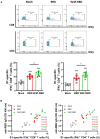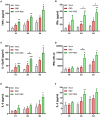A Novel DNA Vaccine Against SARS-CoV-2 Encoding a Chimeric Protein of Its Receptor-Binding Domain (RBD) Fused to the Amino-Terminal Region of Hepatitis B Virus preS1 With a W4P Mutation
- PMID: 33732258
- PMCID: PMC7959807
- DOI: 10.3389/fimmu.2021.637654
A Novel DNA Vaccine Against SARS-CoV-2 Encoding a Chimeric Protein of Its Receptor-Binding Domain (RBD) Fused to the Amino-Terminal Region of Hepatitis B Virus preS1 With a W4P Mutation
Abstract
A coronavirus SARS-CoV-2, which has caused the pandemic viral pneumonia disease COVID-19, significantly threatens global public health, highlighting the need to develop effective and safe vaccines against its infection. In this study, we developed a novel DNA vaccine candidate against SARS-CoV-2 by expressing a chimeric protein of its receptor-binding domain (RBD) fused to a 33-bp sequence (11 aa) from the hepatitis B virus (HBV) preS1 region with a W4P mutation (W4P-RBD) at the N-terminal region and evaluated its immunogenicity. In vitro transfection experiments in multiple cell lines demonstrated that W4P-RBD vs. wild-type RBD protein (W-RBD) led to enhanced production of IL-6 and TNFα at the transcription and translation levels, suggesting the adjuvant potential of N-terminal HBV preS1 sequences for DNA vaccines against SARS-CoV-2. W4P-RBD also led to enhanced production of IgG and IgA, which can neutralize and block SARS-CoV-2 infection in both blood sera and bronchoalveolar lavage (BAL) fluid from the lung in vaccinated mice. Additionally, W4P-RBD led to an enhanced T-cell-mediated cellular immune response under S1 protein stimulation. In summary, W4P-RBD led to robust humoral and cell-mediated immune responses against SARS-CoV-2 in vaccinated mice, highlighting its feasibility as a novel DNA vaccine to protect against SARS-CoV-2 infection.
Keywords: COVID-19; DNA vaccine; HBV preS1; Receptor-binding domain (RBD); SARS-CoV-2; W4P-RBD.
Copyright © 2021 Jeong, Choi, Seo and Kim.
Conflict of interest statement
The authors declare that the research was conducted in the absence of any commercial or financial relationships that could be construed as a potential conflict of interest.
Figures







Similar articles
-
Interferon-armed RBD dimer enhances the immunogenicity of RBD for sterilizing immunity against SARS-CoV-2.Cell Res. 2021 Sep;31(9):1011-1023. doi: 10.1038/s41422-021-00531-8. Epub 2021 Jul 15. Cell Res. 2021. PMID: 34267349 Free PMC article. Clinical Trial.
-
Stabilization of the SARS-CoV-2 Spike Receptor-Binding Domain Using Deep Mutational Scanning and Structure-Based Design.Front Immunol. 2021 Jun 29;12:710263. doi: 10.3389/fimmu.2021.710263. eCollection 2021. Front Immunol. 2021. PMID: 34267764 Free PMC article.
-
Single-Dose Immunization With a Chimpanzee Adenovirus-Based Vaccine Induces Sustained and Protective Immunity Against SARS-CoV-2 Infection.Front Immunol. 2021 Jun 28;12:697074. doi: 10.3389/fimmu.2021.697074. eCollection 2021. Front Immunol. 2021. PMID: 34262569 Free PMC article.
-
Potential for developing a SARS-CoV receptor-binding domain (RBD) recombinant protein as a heterologous human vaccine against coronavirus infectious disease (COVID)-19.Hum Vaccin Immunother. 2020 Jun 2;16(6):1239-1242. doi: 10.1080/21645515.2020.1740560. Epub 2020 Apr 16. Hum Vaccin Immunother. 2020. PMID: 32298218 Free PMC article. Review.
-
A Structural Landscape of Neutralizing Antibodies Against SARS-CoV-2 Receptor Binding Domain.Front Immunol. 2021 Apr 28;12:647934. doi: 10.3389/fimmu.2021.647934. eCollection 2021. Front Immunol. 2021. PMID: 33995366 Free PMC article. Review.
Cited by
-
Antigen-dependent modulation of immune responses to antigen-Fc fusion proteins by Fc-effector functions.Front Immunol. 2023 Oct 5;14:1275193. doi: 10.3389/fimmu.2023.1275193. eCollection 2023. Front Immunol. 2023. PMID: 37868961 Free PMC article.
-
Nucleic acid-based vaccine platforms against the coronavirus disease 19 (COVID-19).Arch Microbiol. 2023 Mar 30;205(4):150. doi: 10.1007/s00203-023-03480-5. Arch Microbiol. 2023. PMID: 36995507 Free PMC article. Review.
-
SARS-CoV-2: Emergence of New Variants and Effectiveness of Vaccines.Front Cell Infect Microbiol. 2021 Dec 14;11:777212. doi: 10.3389/fcimb.2021.777212. eCollection 2021. Front Cell Infect Microbiol. 2021. PMID: 34970509 Free PMC article. Review.
-
A brief review on DNA vaccines in the era of COVID-19.Future Virol. 2021 Nov:10.2217/fvl-2021-0170. doi: 10.2217/fvl-2021-0170. Epub 2021 Nov 26. Future Virol. 2021. PMID: 34858516 Free PMC article. Review.
-
SARS-CoV-2 Mutations and Their Impact on Diagnostics, Therapeutics and Vaccines.Front Med (Lausanne). 2022 Feb 22;9:815389. doi: 10.3389/fmed.2022.815389. eCollection 2022. Front Med (Lausanne). 2022. PMID: 35273977 Free PMC article. Review.
References
Publication types
MeSH terms
Substances
LinkOut - more resources
Full Text Sources
Other Literature Sources
Medical
Miscellaneous

